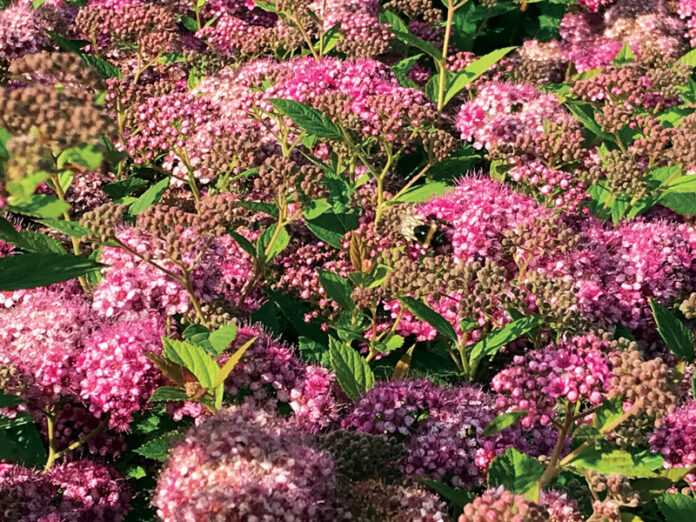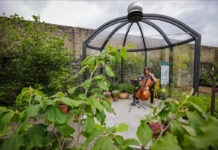Paul Fitters and Dónall Flanagan update on results of Teagasc’s Spiraea quality trials and announce the worthy winners.
Teagasc have been running Spiraea quality trials in Teagasc Ashtown Research Centre, Dublin 15, for the last few years.
41 varieties were assessed between spring 2020 and autumn 2022. The same range was planted in eight other European countries as part of the Eurotrials network. The Eurotrials programme in Ireland has been led by Dr Paul Fitters and has previously assessed Weigela, Hibiscus and Physocarpus.
The other countries participating in the Spiraea quality trials were France, Germany, Belgium, the Netherlands, UK, Finland, Iceland and Austria. The geographic range allowed for the impacts of local climate on the varieties to be observed.
Spiraea japonica are small deciduous shrubs growing to not much more than 1.5m tall. The foliage is dark green. Flowers are generally shades of pink, held in flat terminal panicles measuring up to 15cm across. The flowers appear on new season’s growth in early summer, and flowers repeat occasionally until autumn.
Spiraea aren’t fussy about soil type once it is not overly wet and when established, they can tolerate drought. They are very hardy – many survive to -30oC – however, they can be susceptible to late frost scorches and to powdery mildew. They have the additional benefit of rarely being damaged by deer and rabbits.
Spiraea japonica is the most common species seen in the nursery trade, ‘Firelight’ and ‘Goldmound’ being popular varieties with coloured foliage. Spiraea ‘Anthony Waterer’ have been traded for over 100 years.
Spiraea was widely planted in the ’80s and ’90s and was rightly popular for its good spring and autumn colours and attractive flowers. As fashions have changed, they have become less popular.
Breeding in the last number of years has delivered selections that have greater interest, with better foliage and flower colour. They are more compact and have much better resistance to mildew. Much of the breeding success has come from the USA, Japan and France. Of benefit has been the hybridising between Spiraea japonica and Spiraea fritschiana, which has delivered benefits of pink flowers and coloured foliage.
TRIAL DETAILS
Our trial included 29 S. japonica varieties. The remainder were low-growing species, including: Spiraea betulifolia ‘Tor Gold’, Spiraea betulifolia var. aemiliana, Spiraea decumbens, Spiraea densiflora, Spiraea hayatana and Spiraea watsoniana ‘Kruunu’. These low-growing selections were included as potential ground cover plants. They are very popular in continental cemetery planting due to their low maintenance.
The trial site selected in Teagasc Research Centre Ashtown was south facing, receives sun all day, and had been in grassland for a number of years before the trial.
Each selection was planted from 9cm liners as a solitary plant in a 1m2 plot, and four plants in a 1m2 plot. They received a light top dressing of 7-6-17 each spring. The plots were covered in a weed barrier, and additionally covered with mulch for improved aesthetics. Irrigation was not applied at any point after planting.
Assessments were carried out a number of times a year between 2020 and 2022. Each selection was assessed for overall quality under the headings of flowers, foliage, ground cover and pest and disease incidences. Pollinator flower visits were assessed by some members of Eurotrials, however they were not completed in Ashtown.
The solitary plants were left untrimmed for the entire trial, allowing growth and height to be assessed. The four plants per 1m2 were cut back to 15-20cm each winter and used to assess level of groundcover. A number of judges helped to assess the plants so as to give a broader range of opinions.
RESULTS
Overall the plants in the Ashtown trial faired very well. One species died in the first year of the trial (Spiraea bulata), and it also failed in six of the other eight trial sites. The remainder thrived, including during the drought experienced in the summer of 2020.
Establishment in 2019 may have been helped by the very wet spring of that year. Late frost did cause damage to new growth in 2020, with all plants recovering from this. There was significant mildew pressure during wet weather over the summer of 2021, which helped to identify more resilient species.
Results from other trials partners showed a wide range of performance variance. Mildew in particular was less of an issue in drier countries. Many of our two star performers did very well with other trial sites, suggesting that hotter drier climates are even more favourable than ours.
Six varieties were seen as being of superior quality and received three stars. Eight varieties were of merit and received two stars, with the remaining 27 receiving one or no stars.
WINNERS
Spiraea japonica ‘Albiflora’ is an old established variety. It is compact with white flowers, a novelty for Spiraea japonica.
Spiraea japonica ‘Eiríkur Rauði’ aka ‘Eric the Red’ is mid-sized, 80-100cm, with abundant bright pink flowers in summer followed by red autumn foliage. Bred in Iceland, it is very hardy.
Spiraea japonica ‘Galen’ (‘Double Play Artist’) forms a compact mound 60-80cm in height with red new foliage in the spring followed by masses of purple flowers in the summer. It requires very little maintenance. The ‘Double Play’ Spiraea series are promoted by Proven Winners (a US website that looks for the best plants based on research), as they have both colourful foliage and flowers.
Spiraea japonica ‘Oddi’ is compact 50-60cm in height with characteristic oblong-lanceolate leaves that are longer than in most other cultivars. Striking reddish-brown leaves in late spring are followed by pink flowers in the summer and excellent autumn leaf colour.
Spiraea japonica ‘Óli’ is mid-sized at 80-100cm with abundant bright pink flowers in summer followed by red autumn foliage, similar to ‘Eiríkur Rauði’.
Spiraea ‘Tracy’ was bred in America by plant breeder Timothy Wood, who named it after his wife. The spring flush of foliage is a vibrant orange. As the foliage matures it turns bright yellow with contrasting red new growth. The Royal Boskoop Horticultural Society trials committee in the Netherlands awarded the KVBC-Award Gold Medal to Spiraea ‘Double Play Big Bang® Tracy’ in 2020.
TIME FOR A NEW APPRECIATION?
The trial demonstrated that Spiraea plants are of value and have particular uses in a garden or landscape environment. They showed seasonal interest with good flower colour, excellent spring and autumn foliage, and attractiveness to pollinators. The plants need little attention, with an annual trimming being helpful to keep them to the desired size.
The selection of varieties available has grown since the trial was launched. ‘Double Play Blue Kazoo’ (blue foliage), ‘Double Play® Doozie’ Spiraea (sterile and reblooming), and 2023’s introduction ‘Double Play Candy Corn’ (foliage colour change from red to orange to yellow) are worth investigating.
As current plant trends demand multifunctional plants that help the environment, our trial results suggest that it is time to look again at Spiraea. ✽
DÓNALL FLANAGAN is a nursery stock/ornamentals specialised advisor working with the Teagasc Horticulture Development Department in Ashtown, Dublin 15. He has been working with Teagasc since 2007 and in his current role since 2016.
PAUL FITTERS is a lecturer in the Teagasc College of Amenity Horticulture in the National Botanic Gardens, Dublin. He is a member of the Eurotrial group and coordinator of the Spiraea trials in Ireland.







